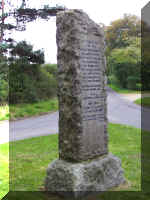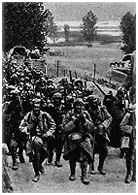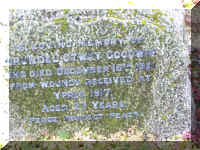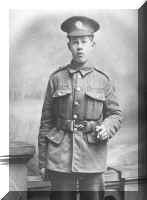World War One
 Most
of the Herringswell men who signed up in the First World War joined the Suffolk
Regiment, the majority of them in the second battalion. The 2nd Battalion,
numbering about 1000 men, had been in Ireland just before the War, things had
been tense when officers had been asked if they were prepared to take action
against local people, they were given the choice of resigning their commissions
without pension. They were bitterly opposed but in the end they did not have to
make that decision, the 1st WW intervened and the Battalion sailed for France in
early August 1914. A week later they were in action making a stand at Le Cateau.
The Battalion was clearly told to make a stand "with no thought of
retirement" despite the difficult and exposed position they were meant to
defend. Subsequent orders to retreat from Mons seemed to pass the Battalion by
as others retreated they were over run and surrounded. Being attacked from all
sides 720 men were killed. The Suffolks clearly needed replacements.
Most
of the Herringswell men who signed up in the First World War joined the Suffolk
Regiment, the majority of them in the second battalion. The 2nd Battalion,
numbering about 1000 men, had been in Ireland just before the War, things had
been tense when officers had been asked if they were prepared to take action
against local people, they were given the choice of resigning their commissions
without pension. They were bitterly opposed but in the end they did not have to
make that decision, the 1st WW intervened and the Battalion sailed for France in
early August 1914. A week later they were in action making a stand at Le Cateau.
The Battalion was clearly told to make a stand "with no thought of
retirement" despite the difficult and exposed position they were meant to
defend. Subsequent orders to retreat from Mons seemed to pass the Battalion by
as others retreated they were over run and surrounded. Being attacked from all
sides 720 men were killed. The Suffolks clearly needed replacements.
On 3rd Dec 1914 a detachment of the Suffolks were present at a medal ceremony
presentation by King George V in France with the Prince of Wales, Edward the
8th. Whilst none of the Suffolk men were decorated this was the first time in
nearly 600 years, since the Black Prince, that an heir apparent to the throne
had been present on the field of battle.
The Christmas Truce
There were signs of tacit agreements to 'live and let live' as soon as
trench warfare began in November 1914. At various points, soldiers on both
sides wrote about lulls in the fighting, especially at breakfast time, and
also during the evening when the rations were brought up to the front
line.
Yet even though informal truces had occurred in almost every major campaign
since the Peninsular War, the extent of the fraternization between British and
German troops during Christmas 1914 was surprising. Contemporary accounts by
officers and ordinary soldiers alike suggest at least two-thirds of the
British-held sector was involved. The French and Belgians had similar
experiences.
Christmas Eve was a beautiful frosty moonlit night, made still more beautiful
when the Germans lit candles on small Christmas trees and propped them on the
parapet "like the footlights of a theatre" as one British soldier
described them. There was carol singing ("I don't think we were so
harmonious as the Germans"). Then came cries of "Hello,
Tommy!", and "Hello, Fritz!" 'Enemies' took tentative steps
into No Man's Land, shook hands, lit each other's cigarettes, and exchanged
gifts of German sausages and cigars, Maconnochie's tinned stew and Wills'
tobacco, family photos and London newspapers.
The truce lasted at least until the end of Boxing Day. At several points it
continued until New Year and on into January. But in other sectors the war
went on as usual. The situation could differ every 200 metres, depending on
the attitude of the battalion commander. Wherever the truce happened, both
sides took the opportunity to bury their dead and to improve their trench
systems. http://www.inflandersfields.be/english/home/index.html
The 2nd Battalion continued to suffer dreadful conditions in the Somme from
the start of 1915, Murphy reports that "men had to undergo periods of
prolonged crouching in water sometimes waist deep". Periods of prolonged
waiting ensued with March reported as starting quietly, however despite not
being sent 'over the top' there were still 140 casualties one of whom was
believed to be the first Herringswell soldier  to
lose his life, Harry Addison from Hall Farm Lodge. Private Addison is remembered
in the church, a plaque states he was 'amongst the first to volunteer, the first
to fall'. His official record with the war graves commission states he died 2
years later, however it is believed by village people that their record is
correct. The commission has been contacted with this new information to try and
get his records corrected.
to
lose his life, Harry Addison from Hall Farm Lodge. Private Addison is remembered
in the church, a plaque states he was 'amongst the first to volunteer, the first
to fall'. His official record with the war graves commission states he died 2
years later, however it is believed by village people that their record is
correct. The commission has been contacted with this new information to try and
get his records corrected.
Unusually the 1st and 2nd Battalions met up with each other in April 1915,
potentially giving the opportunity for Herringswell soldiers to great each other
for the first time since they joined. This was just before the 1st Battalion
fought in the Battle of Ypres at St Julien. For the first time they suffered
horrendous gas attacks, by the end of April another 400 Suffolk soldiers had
been killed. Before dawn on 8th May 1915 Captain Balders toured the trenches and
warned all ranks that an attack was expected at any moment. His message was that
the Battalion was being relied upon, once again, to "yield no ground,
but to stand to the last". At dawn a violent shelling began. At 10 am
the attack was launched with gas and by the end of the day there were another
400 casualties, presumed to include the death of Charles Scott, (noted as Lance
Corporal on the official war graves Ypres (Menin Gate) memorial and as Private
on Herringswell's village memorial). The war Commission's memorial on the road
to Menin "bears the names of men who were lost without trace during the
defence of the Ypres Salient".
The War Commission writes:
Second Battle of Ieper
On 22 April 1915, at 5 pm, a greenish-yellow cloud rose slowly into the
air from the German lines at Steenstrate. This was chlorine gas. The French
and Algerian soldiers in the front line fled to the rear, yet many of them
would never reach safety. In a few hours' time, the Germans had moved forward
four kilometres towards the Ieper-IJzer Canal. The speed of their advance
surprised even them. The German troops were given the order to dig themselves
in.
Following the gas attack, the Allied commanders realized that Ieper was now in
danger. The Canadians therefore launched a counterattack to cover the flanks
of the retreating French. They were joined the next day by the British,
Indians and Belgians. This marked the start of the Second Battle of Ieper. The
fighting would last five weeks.
The threat was greatest to the north of Ieper, where German units had crossed
the Ieperlee Canal in two places. Inch by inch, French and Belgian troops
managed to drive them back. However, heavy German shelling and renewed gas
attacks claimed many lives. The positions at Passendale, Zonnebeke and Polygon
Wood were all cleared.
To the east of Ieper, the Germans were confronted by British troops. At Hill
60, Sanctuary Wood and Hoge, there was fierce fighting for every inch of
ground.
The civilians who hadn't already fled from Ieper were now ordered to evacuate.
Even Camille Delaere, the enterprising priest of St Peter's, and Geoffrey
Winthrop Young, the head of the voluntary Friends' Ambulance Unit, were told
to leave the city. Only the military remained. Although Ieper was still in
British hands, it was by now little more than a deserted ruin.
The Second Battle of Ieper drew to a close at the end of May, due to lack of
ammunition and manpower. The Germans had succeeded in pushing forward several
kilometres across a large part of the Ieper Salient, thereby advancing ever
closer to the city. Five weeks of fighting had taken a heavy toll. The Germans
had lost 35,000 dead and wounded, the British 60,000, the French 10,000 and
the Belgians 1,500.
An A. Hunt, believed to be Private Alfred Hunt of Herringswell died on 30th
September 1915 and is buried at the Perth Cemetery East of Ypres near the great
communication trench known as the Great Wall of China.
At the end of the year 1915 the 9th Battalion was still in Ypres. They had
suffered gas attacks before Christmas but fared better than previously with the
proper use of their simple but effective gas masks. In January most of the 9th's
casualties were caused by shelling and on the 15th Arundel Goodwin died. He
missed what was described as the "welcome change of equipment from leather
to webbing".
The 8th Battalion were fighting on the Somme in July 1916. Private Orlando
Murton died on the 18th. The battle at this time is described as "at
midnight on July 18/19 the brigade was unexpectedly launched at very short
notice and with no reconnaissance in a most unenviable counter attack designed
to clear the village (Longueval) and wood. By the time the brigade was assembled
and the necessary orders had been issued it was already dawn. The 2 miles of
open country had to be traversed in broad daylight with every available German
gun trained on the assaulting troops". The attackers were described as
"they moved forward with courage". The attack was felt to be largely
unsuccessful, eventually gaining just 300 yards.
The 2nd Battalion was also involved in the renewed attacks on Longueval and
Delville wood. "The 2 Suffolk companies in the forward line moved in
double lines of platoons with a front of 140 yards each". Private Percy
Sparkes died on the 20th July following "much bitter fighting which,
though indecisive locally, enabled another division to gain a footing".
The War Graves Commission writes the following
The Somme The long-drawn-out fighting at Verdun was progressively
exhausting the French army. At the request of the French, the British
therefore launched a huge diversionary attack further west. This would become
known as the Battle of the Somme.
The United Kingdom was the last of the major protagonists to introduce
mandatory conscription, which it did in early 1916. As the Battle of the Somme
claimed more lives, conscripts were drafted in to take the place of the
professional soldiers and volunteers.
1 July 1916, the first day of the Somme, was a disaster. For an entire week,
the British artillery had fired off more than 1.5 million shells. The British
firmly believed that nothing would be left of the enemy. But the Germans were
so deep underground that most had survived the bombardment. Moreover, the
British shells were of very uneven quality. The result when the British
emerged from their trenches was sheer slaughter. In one single day alone, they
lost more than 57,000 dead and wounded.
On 15 September, at Flers, the British unveiled a new weapon the tank.
However, 31 of the 49 tanks used during the attack succumbed to mechanical
difficulties.
The Battle of the Somme did not end until mid-November, with the approach of
winter. By this time, the British had lost 400,000 (dead, missing, wounded or
prisoners-of-war). The Germans had lost an equal number, the French half that
figure. These enormous sacrifices had won the Allies barely 12 kilometres of
ground.
The Somme was to the British what Verdun was to the French. The losses of 1
July were especially traumatic, and helped to dispel forever any remaining
illusions about the invincibility of the Empire. After the disasters of Verdun
and the Somme, no-one knew how to go on. The German Prince Max von Baden
wrote: "1916 ended in bitter disappointment for both sides. Both we
and our enemies had spilled the blood of the best of our manhood, yet without
coming a single step closer to victory." http://www.inflandersfields.be/english/home/index.html
The end of March 1918 saw a great German Offensive in the Sensee
Valley. The hill where Private Edwin Frost is buried had been captured by the
Cavalry Corps in October 1914 and was held throughout the Battle of the Lys
despite the 9th Battalion having to withdraw from their position with heavy
casualties. Their new positions continued to see "heavy fighting with
the Suffolk Battalions overwhelmed". Both battles saw over 700
casualties, Private Edwin Frost died on the 19th April.
Other Herringswell men who died included Captain Leslie Balance of the Kings
Royal Rifles who died at the Somme on 27th September 1916. A church plaque
states "whilst performing a dangerous duty for which he had
volunteered". And Private Henry Nunn of the 1st Battalion Royal
Fusiliers who died 31st March 1917
 It
is unknown how many men returned to Herringswell from WW1. Gunner Arundel e o
Goodwin came back wounded and died from those wounds in 1921. He was buried in
Herringswell Churchyard.
It
is unknown how many men returned to Herringswell from WW1. Gunner Arundel e o
Goodwin came back wounded and died from those wounds in 1921. He was buried in
Herringswell Churchyard.
 The
young man Walter Nunn (pictured here) returned to work on the estate as a
gamekeeper, clearly, as these records show, so many men from such a small
village did not.
The
young man Walter Nunn (pictured here) returned to work on the estate as a
gamekeeper, clearly, as these records show, so many men from such a small
village did not.
Information, unless otherwise marked, is taken from Lieutenant Colonel C
Murphy. The History of the Suffolk Regiment 1914 - 1927. Hutchinson 1928.
